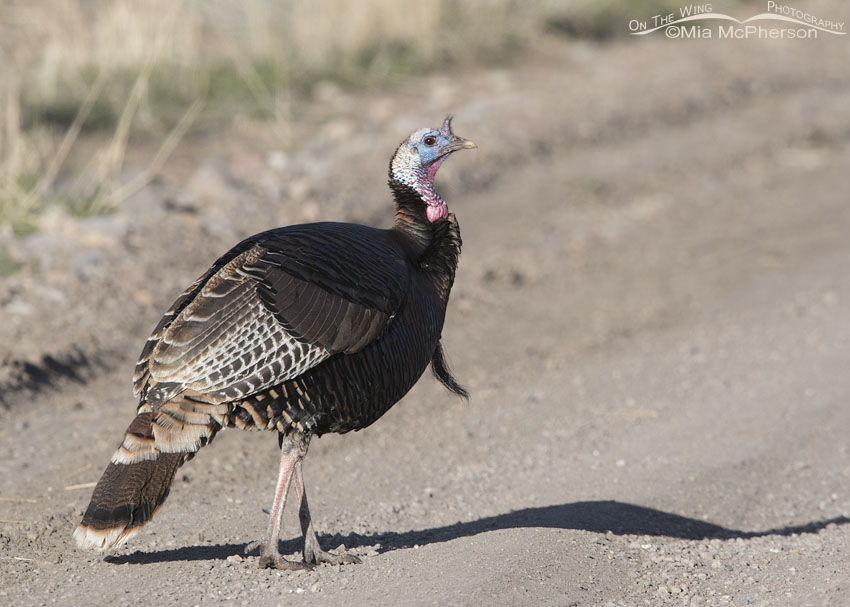 Wild Turkey tom crossing a road – Nikon D500, f7.1, 1/1600, ISO 640, Nikkor 500mm VR with 1.4x TC, natural light
Wild Turkey tom crossing a road – Nikon D500, f7.1, 1/1600, ISO 640, Nikkor 500mm VR with 1.4x TC, natural light
Breeding season has begun for Wild Turkeys so when I spotted a flock of them yesterday in the West Desert in Tooele County I was hoping to photograph a tom turkey strutting. I haven’t photographed that behavior before and the thought excited me.
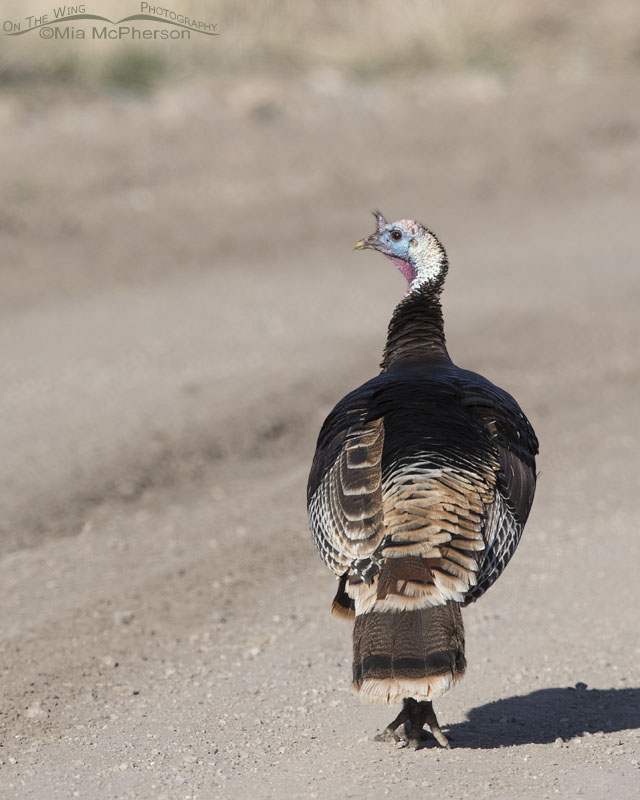 Back view of a tom Turkey – Nikon D500, f7.1, 1/1600, ISO 640, Nikkor 500mm VR with 1.4x TC, natural light
Back view of a tom Turkey – Nikon D500, f7.1, 1/1600, ISO 640, Nikkor 500mm VR with 1.4x TC, natural light
The tom wasn’t all that cooperative though and most of the time when he fanned his tail out fully he kept his back to me. He’d strut a bit, stop, drop his wings and fan his tail and repeat. I don’t recall this tom gobbling while I photographed him at all. In this photo the turkey had just stopped displaying his fanned out tail and gave me a nice head turn and view of his backside.
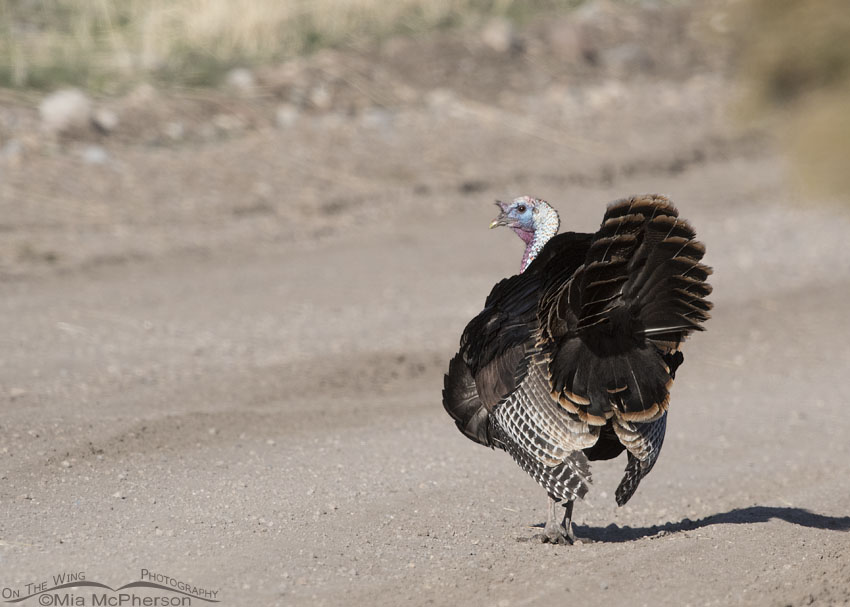 Strutting Wild Turkey tom – Nikon D500, f7.1, 1/2000, ISO 640, Nikkor 500mm VR with 1.4x TC, natural light
Strutting Wild Turkey tom – Nikon D500, f7.1, 1/2000, ISO 640, Nikkor 500mm VR with 1.4x TC, natural light
As the Wild Turkey moved uphill on the road he stopped once again, dropped his wings and fanned out his tail while giving me a head turn. I wish I had a full frontal view or even a side view of him in this pose out in the open but again he didn’t give me those views.
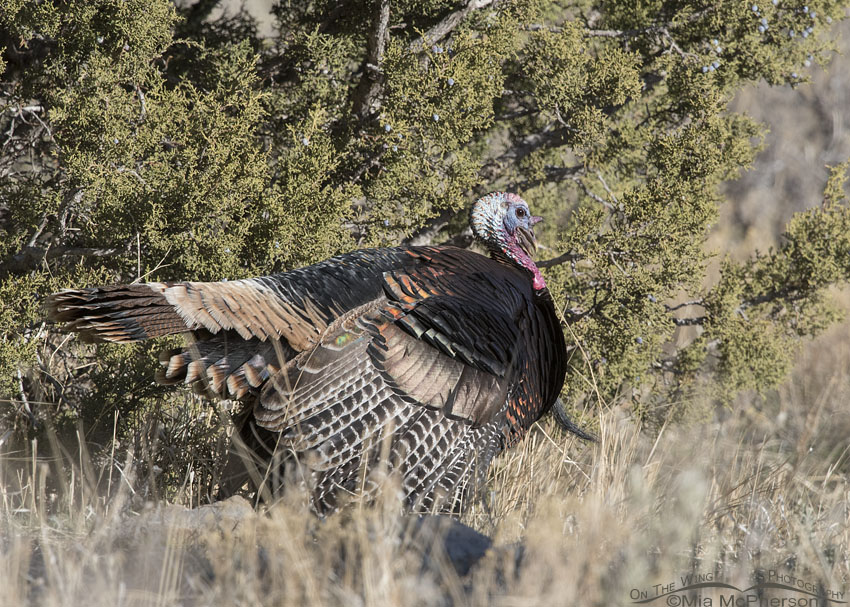 Wild Turkey tom displaying in the Stansbury Mountains – Nikon D500, f7.1, 1/1600, ISO 640, -0.3 EV, Nikkor 500mm VR with 1.4x TC, natural light
Wild Turkey tom displaying in the Stansbury Mountains – Nikon D500, f7.1, 1/1600, ISO 640, -0.3 EV, Nikkor 500mm VR with 1.4x TC, natural light
I was able to take side views of him displaying but he had moved onto the grass, sagebrush and juniper covered hillside and I couldn’t get a completely clear view of the tom turkey. The bright grasses in the foreground are just a touch distracting to my eyes.
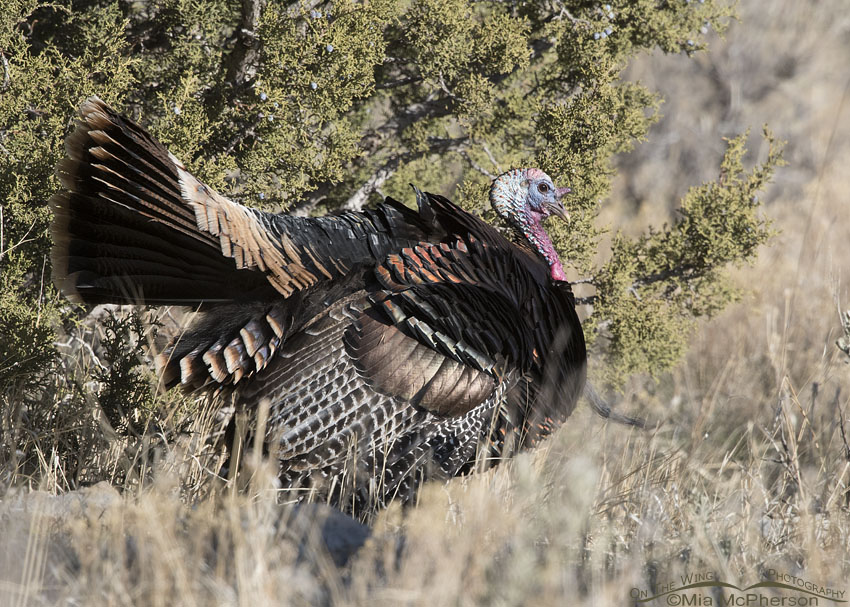 Displaying Wild Turkey tom – Nikon D500, f7.1, 1/1600, ISO 640, -0.3 EV, Nikkor 500mm VR with 1.4x TC, natural light
Displaying Wild Turkey tom – Nikon D500, f7.1, 1/1600, ISO 640, -0.3 EV, Nikkor 500mm VR with 1.4x TC, natural light
This tom is from the Southwestern subspecies; Meleagris gallopavo intermedia, also known as a Rio Grande Wild Turkey. In southern Utah both the Rio Grande and Merriam’s turkeys can be found. Wild Turkeys can be very skittish but the turkeys I photographed yesterday didn’t seem like they were bothered much at all. They all slowly moved uphill and out of sight.
Seeing wild turkeys reminds me of a time years ago when my youngest son and I were in the woods of southern Georgia well before dawn and had leaned up against a tree and each other where both of us dozed while waiting for the sun to come up. Just about dawn I heard my son whispering to me “Mom, wake up, look!” and when I opened my eyes I could see a flock of about 12 to 15 turkeys feeding quietly no more than 15 feet from us. I guess they knew it was deer season and not turkey season? Just kidding about that because the birds couldn’t “know” which season it was but it was incredible for us to sit side by side and watch them slowly moving through the clearing in front of us. Both of us had smiles on our lips and a shared memory that I hope I never forget.
Or the time I sent my oldest son out into my garden in Virginia to round up a turkey poult that couldn’t figure out how to get through the chain link fence to join the rest of its family who had finished messing up my garden and were headed back into the woods. My son caught the poult and gently dropped it on the other side of the fence where it scurried to catch up with the rest of the turkeys while I watched from the kitchen window. He, my son not the turkey, had a big grin on his face and I could tell he felt good for helping that turkey poult out.
So every time I see and photograph Wild Turkeys I’m always reminded of both my sons too.
Life is good.
Mia
Click here to see more of my Wild Turkey photos plus facts and information about this species.


I love your pics Miap. I have never seen wild turkeys quite as impressive as the toms you captured but I do have a story to share. Just last October as I was driving down a small winding road near Julian – a mountain community about 50 miles northeast of San Diego – a wild turkey strolled out of the underbrush. As I watched him cross in front of me, he was followed by another; then another. I counted twelve turkeys in all; pretty much marching in single file. It was an amazing sight. Of course, I did not have either a camera or my cell phone with me so the moment could not be recorded. But it is one hell of a memory. Thanks for taking me back to it.
Thank you for yet another bird I will not see. So very much.
As I have mentioned before I have been seeing more wild turkeys this fall and winter than ever before. Huge groups! I like the term posse, the group up Emigration canyon definitely acts like they own the place. They hang out in and close to the road. I worry they will be hit by a non local who speeds around the curve not expecting them to be in the middle of the road.
Great shots, you would have loved the one I saw on the way to town. Of course no camera, and a very curvy mt, road with no place to stop. But he was gorgeous.
Great shots, great memories…these birds are so beautiful! Love the vareity of colors and feathers…patterns, shapes, sizes…wish I coukd see them more often…..